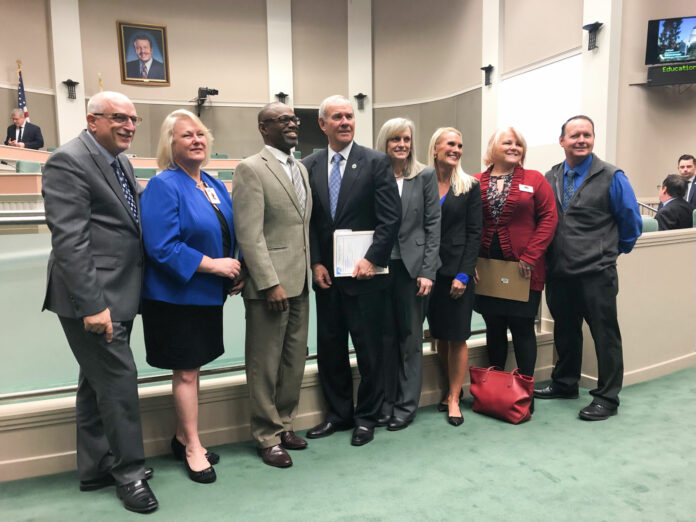
Outlines six areas of state assistance needed to prepare for future disaster
On Wednesday, Feb. 6, Sonoma County Superintendent of Schools Steve Herrington participated in a panel before California’s Assembly Education Committee to share lessons learned from his experience responding to the 2017 Tubbs fire as well as assisting Butte and Shasta county schools following the fires that devastated their communities.
Herrington joined Zoe Miller, a teacher from Piner High School in Santa Rosa, along with numerous state officials and county superintendents from Butte, Shasta and Ventura counties at the committee’s informational hearing titled “The impact of California Wildfires on Public Schools: Response and Recovery.”
Miller shared her experience as a parent and community member who lost her home in the Tubbs fire, as well as a teacher serving students who were impacted by the fire’s devastation and the aftermath of its economic toll on the community. She spoke of the need for continued mental health support for staff and students.
“Today I’d like to present for your consideration some unique challenges that an urban wildfire can pose for schools and some possible solutions,” Herrington said.
Herrington’s comments focused on six areas where he felt some lessons had been learned about what was needed in the wake of such disasters: protection school funding, developing a protocol for opening schools after a fire, creating an air quality standard for school closures in smoky conditions, designate county offices as lead agencies during fire disasters, create a toolkit for districts to use during fire emergencies and create ongoing mental health support for school communities.
In the wake of the 2017 fires, local school districts were faced with potential funding issues, primairly due to lost ADA funding as schools shuttered. While the state did provide funding backfill, charter schools were left out of the plan.
“Thanks to action on the part of the legislature to create a hold harmless provision in the 2018-19 budget, Sonoma County school districts were protected from losing funding if five percent or more of the housing within their boundaries was lost. However, in looking closer at the language included in A.B. 1840, we found that this did not apply to charter schools that were impacted — only school districts. For Sonoma County, this left some of the hardest hit areas including Coffey Park and Mark West with funding decreases to areas served by dependent charter schools,” Herrington said.
Herrington encouraged the development of standard statutory language to “hold harmless” local educational agencies — including school districts, charter schools and county offices — in future disasters.
Herrrington also looked to legislators to help a standardized protocol for reopening school sites after they have been impacted by a toxic fire. Though, according to Herrington, there are protocols for reopening school sites after earthquakes, prior to the October 2017 Tubbs fire, none were in place for opening school sites impacted by toxic ash, debris and smoke.
At the time of the Tubbs fire, a special state task force was convened to assist districts, and Herrington hopes such a task force will be left in place for future disasters. In addition, he stated guidance is needed for districts and counties from the Environmental Protection Agency regarding how toxic ash should be dealt with.
“Likewise,” Herrington said, “standardized guidance is needed to help schools determine when to close and how to ensure student safety when air quality is hazardous. After the Camp Fire, toxic smoke covered a large region for more than a week. This put schools in the challenging position of trying to act as public health experts in determining when it was appropriate to keep schools open.
“In speaking with air quality experts and public health officials, my office has learned that the science around air quality from urban wildfires is still evolving,” he continued. “There is disagreement over the best air quality monitoring site to use, whether it is better to keep school open or close school; and whether to hand out masks or not. I encourage you to convene experts in pediatric health, public health and air quality to determine a standardized set of recommendations.”
Areas of particular interest, according to Herrington, include: What air quality monitoring site should be used; when, if ever, schools should close due to poor air quality? Many schools chose to stay open because they saw it as an equity issue to provide a clean air environment for disadvantaged students. Also included were how to equip schools with filtration that ensures good air quality; when can schools expect to be reimbursed for closing due to air quality concerns; and, finally, should N95 masks be distributed to children and/or educators, as Herrington has received conflicting information on this topic.
Herrington related that in 2017, SCOE acted as lead agency for public and private schools during the disaster, including for local area private schools. He recommended that this arrangemnt be codifed at the state level.
“Unfortunately, the likelihood of similar disasters impacting other educational communities in the months and years ahead is very high,” Herrington said. “My office is working with the California County Superintendents’ Association (CCSESA) to develop a toolkit for county offices that can be used in future wildfire disasters. I encourage the legislature to work with CCSESA in the development of this state toolkit.”
Finally, both Herrington and Miller discussed far-reaching and long-lasting mental health impacts of fire disasters.
“Sonoma County schools are still dealing with students and staff who have been traumatized. We were fortunate to benefit from grants that allowed us to contract with experts and provide training and resources to our schools and families. Not every impacted community has not been this lucky,” Herrington said. “It would be very helpful if California’s Mental Health Services division could provide a line of support to schools to assist them in dealing with these issues. Addressing student and teacher trauma will enable our communities to heal and our students to thrive and develop resilience in the face of adversity.”







